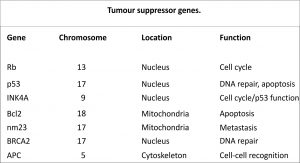Tumor Suppressor genes
Tumor-suppressor genes generally encode proteins that in one way or another inhibit cell proliferation.Five broad classes of proteins are generally recognized as being encoded by tumor-suppressor genes:
- Intracellular proteins that regulate or inhibit progression through a specific stage of the cell cycle (e.g., p16 and Rb, retinoblastoma).
- Receptors or signal transducers for secreted hormones or developmental signals that inhibit cell proliferation (e.g., TGF-β, the hedgehog receptor patched).
- Checkpoint-control proteins that arrest the cell cycle if DNA is damaged or chromosomes are abnormal (e.g., p53).
- Proteins that promote apoptosis.
- Enzymes that participate in DNA repair. Although DNA-repair enzymes do not directly inhibit cell proliferation, cells that have lost the ability to repair errors, gaps, or broken ends in DNA accumulate mutations in many genes, including those that are critical in controlling cell growth and proliferation. Thus loss-of-function mutations in the genes encoding DNA-repair enzymes prevent cells from correcting mutations that inactivate tumor suppressor genes or activate oncogenes. Generally one copy of a tumor-suppressor gene suffices to control cell proliferation, therefore, both alleles of a tumor suppressor gene must be lost or inactivated in order to promote tumor development. Thus, oncogenic loss-of function mutations in tumor-suppressor genes are genetically recessive. In many cancers, tumor-suppressor genes have deletions or point mutations that prevent production of any protein orlead to production of a non functional protein Examples of tumor suppressor genes
i) Rb (Retinoblastoma)
Rb is a tumor suppressor gene. The Rb protein controls cell cycle moving past the G1 checkpoint. Rb protein binds to the regulatory transcription factor E2F. The factor E2F is required for synthesis of replication enzymes. Upon binding of Rb to E2F,no transcription/ replication can take place. Rb restricts the cell’s ability to replicate DNA by preventing its progression from the G1 (first gap phase) to S (synthesis phase) phase of the cell division cycle.Rb is phosphorylated to pRb by certain Cyclin Dependent Kinases (CDKs). The phosphorylated/ mutated form of Rb (pRb) is unable to complex E2F and therefore, unable to restrict progression from the G1 phase to the S phase of the cell cycle. When E2F is free it activates factors like cyclins (e.g. Cyclin E and A), which push the cell through the cell cycle by activating cyclin-dependent kinases, this lead to cell division and progression of cancer.
ii) p53
Tumor protein p53, also known as p53, cellular tumor antigen p53, phosphoprotein p53 is a tumor suppressor gene. The name p53 is in reference to its apparent molecular mass: SDS-PAGE analysis indicates that it is a 53- kilodalton (kDa) protein. p53 has many mechanisms of anticancer function, and also plays a role in apoptosis, genomic stability, and inhibition of angiogenesis.p53 acts as a transcription factor for gene p21. It activates p21 which in turn bindsto CDK I (cyclin dependent kinase 1). When p21is complexed with CDK1 the cell cannot continue to the next stage of cell division. A mutant p53 can not bind DNA in an effective way, and, as a consequence, the p21 protein will not be available to act as the “stop signal” for cell division. This leads to uncontrolled cell proliferation and cancer. More than 50% cases of cancer involve mutation of p53 gene.
